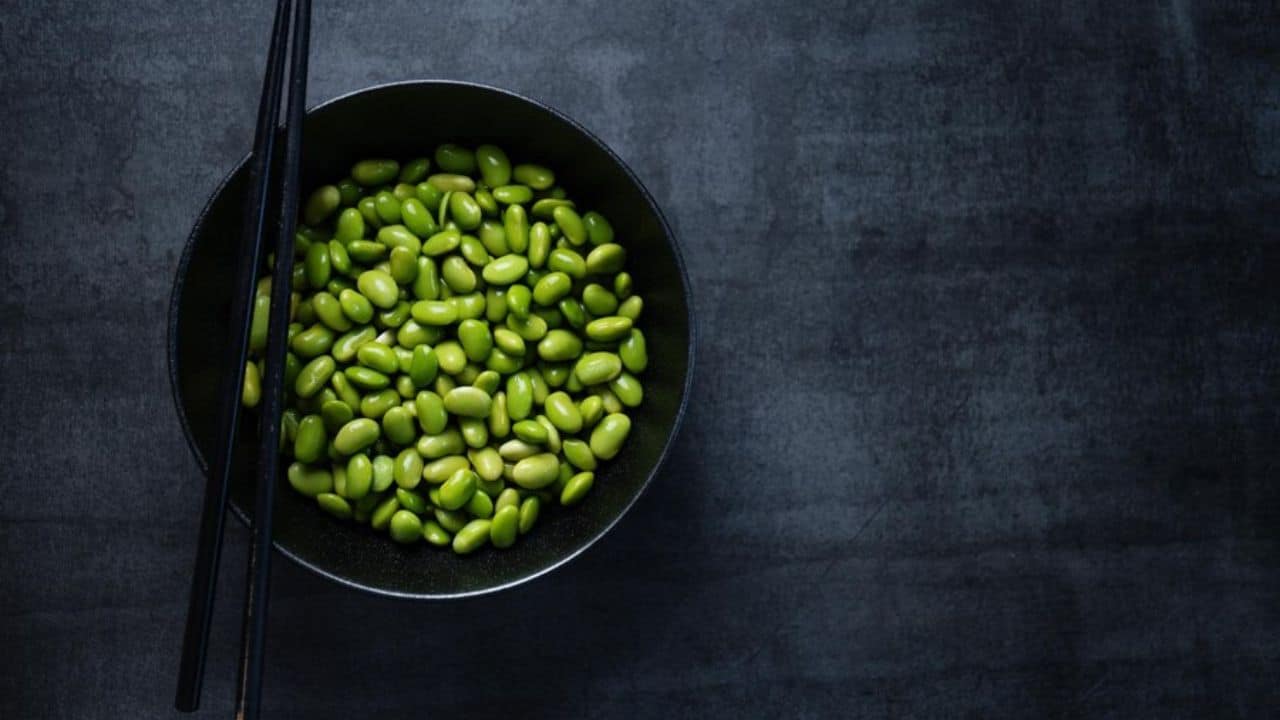Edamame, also known as soybeans, is one of the world’s most widely used and versatile foods. Not only are they eaten whole out of their pod, but they are also processed into tofu, soy protein, soybean oil, miso, soy sauce, and tempeh. While edamame originated in Asia, the soybeans’ popularity has increased in Western diets as well. It’s commonly eaten as an appetizer at your favorite sushi restaurant, a topping for poke bowls, or roasted for a crunchy and satisfying snack.
Keep reading to find out the many ways you can eat edamame and get maximum satisfaction.
Table of contents
- What Are The Benefits Of Eating Edamame?
- How To Eat Edamame
- How To Serve Edamame
- How To Cook Edamame
- How To Boil Edamame
- How To Steam Edamame
- How Can I Microwave Edamame
- How to Cook Edamame on the Stovetop
- 9 Recipe Ideas for Edamame
- How To Store Edamame
- Can I Eat Edamame Raw?
- Why Can’t You Eat The Body Of Edamame?
- FAQs On How To Eat Edamame
- Conclusion
- References
- We Also Recommend
What Is Edamame?
Edamame are young soybeans, green and unripe in their pods. The green soybeans are picked early, unlike mature soybeans that are dry and firm, and used for making soy products like tofu and soymilk. When cooked, edamame beans are consumed directly from the pod, with the outer shell discarded.
For convenience, hulled edamame beans are available and can be found in the frozen section of Asian grocery stores. These shelled beans can be effortlessly incorporated into salads and stir-fries or used to create dips.
What Are The Benefits Of Eating Edamame?
Here are a few benefits of eating edamame:
- Nutrient-Rich: Edamame is packed with essential nutrients, including protein, fiber, vitamins (such as vitamin K, vitamin C, and folate), and minerals (like iron and magnesium).
- Protein Source: Edamame is a plant-based protein source, making it an excellent option for individuals looking to increase protein intake without relying on animal products.
- Heart Health: The soy content in edamame is linked to heart health. It may help lower cholesterol levels and reduce the risk of cardiovascular diseases.
- Rich in Antioxidants: Edamame contains antioxidants, including phytochemicals and isoflavones, which may contribute to neutralizing harmful free radicals in the body.
- Bone Health: The presence of vitamin K in edamame is beneficial for bone health, as it plays a role in bone mineralization and blood clotting.
- Digestive Health: The high fiber content in edamame supports digestive health by promoting regular bowel movements and maintaining a healthy gut.
SEE ALSO: How Do Cashews Grow – Botanical Growth Exploration
How To Eat Edamame
While getting the little beans out of the pod is an extra step that you don’t have with, say, snap peas, these protein-rich bad boys are well worth the work.
Here are three ways you can eat edamame:
1. Eat it as a snack
Sushi restaurants commonly offer edamame as a starter, presenting it steamed in a pod and seasoned with salt. If you wish to prepare it at home, obtain fresh or easily accessible frozen edamame in the pod. Steam or boil until the pods turn a vibrant green and are thoroughly warmed. Remove any excess water, then sprinkle with sea salt and, if desired, a touch of black pepper.
To consume, use your front teeth to gently extract one bean at a time from the pod—they should come out easily with a slight popping sensation.
2. Shell the beans and cook with them
Some stores sell frozen shelled edamame beans, which you can steam in a pot or in the microwave. If you can only find them in-shell, you’ll have to cook them up that way and squeeze each bean out manually.
Once you have them shelled, add the beans to super-simple fried rice dinners, cheesy, herbaceous salads, protein-rich veggie burgers, and weekday [stir-fries].
3. Mash the edamame into a puree
Edamame can be employed similarly to green peas or other beans, such as being mashed on toast. For those feeling particularly inventive, consider adding edamame to your next ice cream batch—showcasing the delightful and adaptable nature of this small bean.
How To Serve Edamame
In Japan, edamame pods are a widely enjoyed snack, frequently served in restaurants as an appetizer or paired with a refreshing glass of beer. Typically, edamame is blanched in mildly salted water and presented in the pods, served either warm or chilled. Consuming edamame is uncomplicated: one simply squeezes the beans out of the pods directly into the mouth, discarding the shells into a separate bowl.
How To Cook Edamame
The two best ways to cook whole edamame are to boil the pods in lightly salted water, or steam your edamame and finish with a sprinkle with a bit of sea salt. Edamame can be enjoyed warm, cold, or at room temperature.
How To Boil Edamame
Add in-shell edamame to a pot of salted, boiling water. Boil frozen edamame for one to two minutes and fresh edamame for five to six minutes until the beans are bright green and tender. Drain and rinse pods in cold water.
READ ALSO: How to Make Candy Grapes: Creative Snack Preparation
How To Steam Edamame
In a medium-sized pot, add an inch of water and bring it to a boil. Put the edamame in a steaming basket, cover the pot with a lid, and steam for eight to ten minutes if using fresh edamame or two to three minutes for frozen edamame. Conclude the preparation by adding a sprinkle of flaky sea salt.
How Can I Microwave Edamame
Place frozen edamame in a bowl and add half a teaspoon of water. Cover and microwave on high for three minutes.
How to Cook Edamame on the Stovetop
Heat a large cast-iron skillet over medium heat. Place two tablespoons of olive oil in a skillet, followed by edamame. Cook, tossing often until edamame is blistered, about five minutes. Finish with flaky sea salt.
You can easily find fresh and frozen edamame in the Asian stores or Speciality Vegan Stores.
It’s also available around the year in the frozen section. You can buy shelled edamame or still in the pods. Frozen Edameme is usually balanced and flash frozen just like peas.
READ ALSO: How Long to Cook a Hot Pocket – Culinary Timing Precision
9 Recipe Ideas for Edamame
- Spice edamame recipe: After boiling or steaming whole edamame beans, sprinkle them with different toppings like flaky sea salt, gochugaru (Korean red pepper powder), grated parmesan cheese, fresh lime juice, grated garlic, sesame seeds, and sumac.
- Noodle soup with edamame: Keep a bag of frozen shelled edamame in your freezer for an easy source of protein for your Asian noodle soups. Dress up ramen, soba, udon noodles, and rice noodles with a handful of these tasty beans. Add the frozen beans directly to the simmering broth two minutes before the end of your cooking time.
- Healthy fried rice with edamame: Make a healthier version of your favorite Chinese take-out by adding edamame to fried rice with brown rice, carrots, scrambled egg whites, garlic, soy sauce (or tamari), and scallions.
- Shrimp and edamame stir-fry recipe: Make a healthy, protein-packed stir-fry using shrimp, string beans, red peppers, and edamame, all garnished with fresh cilantro, green onions, and sesame seeds.
- Soba noodle salad recipe: For a refreshing, healthy meal try making a cold soba noodle salad. Cold noodles are combined with edamame beans, julienned carrots, bell peppers, grated cucumbers, and green onions. Toss with sesame oil and rice vinegar dressing.
- Edamame hummus: To make a healthy dip, try adding edamame beans to your hummus. In a food processor, combine 1 ½ cups cooked edamame beans, ¼ cup tahini, ¼ cup water, 1 teaspoon grated lemon zest, 1 garlic clove, 1 teaspoon cumin, and juice from one lemon. Season with salt and serve with veggies for dipping.
- Soba noodle salad recipe: For a refreshing, healthy meal try making a cold soba noodle salad. Cold noodles are combined with edamame beans, julienned carrots, bell peppers, grated cucumbers, and green onions. Toss with sesame oil and rice vinegar dressing.
How To Store Edamame
Once cooked, edamame pods can be stored in an airtight container for one to two days in the refrigerator. Cooked edamame can also be frozen or shelled and frozen, and stored in resealable bags in the freezer for two to three months.
Can I Eat Edamame Raw?
Any soybean must be cooked before consumption, as all raw soy protein is considered poisonous.
Why Can’t You Eat The Body Of Edamame?
Edamame pods are not poisonous, they are tough to chew and could pose difficulties in swallowing and digestion. Consequently, the pods are considered inedible, unlike the tender beans they encase.
READ ALSO: How to Cook Bratwurst: Culinary Expertise Development
FAQs On How To Eat Edamame
Yes, edamame can be cooked by boiling, steaming, or microwaving. The choice of cooking method depends on personal preference and convenience.
Yes, edamame can be seasoned with various toppings such as sea salt, soy sauce, or chili flakes for added flavor.
Edamame is often available in the frozen food section of grocery stores. It can also be found in Asian grocery stores, either frozen or fresh.
Individuals with soy allergies should avoid edamame, as it is derived from soybeans. It’s crucial to check food labels for potential allergens.
Conclusion
Now that you know the basics on how to eat edamame, which is your favorite?
References
- epicurious.com – How to Eat Edamame, In and Out of the Shell
- yellowthyme.com – THE ULTIMATE GUIDE ON HOW TO EAT EDAMAME





